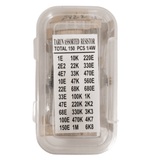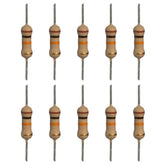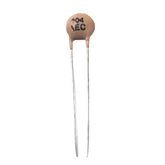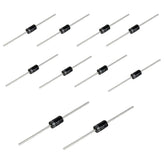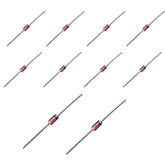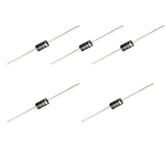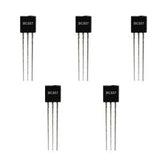Types of Electronic Components
Summary
Explore the fascinating world of electronic components in our latest blog! Dive into the Introduction to understand the foundation of electronic circuits. Uncover the vital role Resistors play in regulating electrical flow, followed by a look at the energy-storing magic of Capacitors and the magnetic forces of Inductors. Demystify the function of Diodes and the amplifying wonders of Transistors. The journey through the blog culminates in a comprehensive Conclusion, tying together the intricate dance of these essential components. Don't miss out on this electrifying read that sparks curiosity and illuminates the core of modern technology!
From smartphones to appliances, electronics permeate every aspect of modern daily life. Under the hood of these intricate devices lies complex circuitry, at the core of which sit several fundamental electronic components. Like letters spelling words and words forming sentences, these crucial basic blocks connect to enable all electronic functionality.
This article will provide an illuminating glimpse into the five most ubiquitous categories of electronic components - their construction, critical characteristics, and primary purposes. A firm grasp of these electronic unsung heroes facilitates effective circuit design and swift diagnosis of issues.
Resistors

The most omnipresent of electronic constituents, resistors are components explicitly engineered to resist electric current flow to precise degrees. By strategically employing resistors, technicians manipulate voltage and current in myriad ways.
Unlike generic conductors transferring energy freely, resistors are constructed from non-conductive solid substances like carbon, ceramics, plastics, or metals. The exact chemical composition and geometric design defines the resistor's resistivity - its effectiveness in impeding current. Generally, longer and thinner resistors demonstrate higher resistance and vice versa.
Specialized Types for Diverse Applications
From general-purpose fixed carbon film resistors to variable models like potentiometers, various resistor configurations serve different needs. While standard resistors boast set resistance values, adjustable types permit live tuning of resistance. Other models like metal film resistors and wirewound resistors handle higher wattages or yield enhanced temperature coefficients.
Key Properties Determine Functionality
- Resistance Value in Ohms - The resistor rating denoting opposition to current flow. Varies exponentially from fractions of an Ohm to billions of Ohms.
- Power Rating in Watts - Indicates maximum power the component can dissipate without failure.
- Resistance Tolerance - The permissible deviation from stated resistance value, e.g. +/-5%.
- Temperature Coefficient - Resistance change rate corresponding to temperature change.
Critical Roles in Electronic Circuits
Owing to their inherent resistivity, resistors influence current levels, divide voltages, and terminate transmission lines. Common applications include:
- Current Limiting - Preventing excessive current flow in LEDs and transistors
- Voltage Division - Producing specific voltages from a higher supply
- Pull Up/Pull Down - Establishing predefined voltage levels for digital logic circuits
- Waveform Shaping - Modifying signal characteristics
Capacitors

Capacitors are passive components that temporarily store and discharge electrical energy in the form of an electrostatic field. This ability makes them ideal for filtering signals, tuning frequencies, and energy storage.
In their most elementary form, capacitors consist of two conducting plates sandwiching a dielectric or insulating substance. When connected to a power source, electrons accumulate on one plate, inducing an opposite charge on the other, thereby storing energy in the generated electric field between the plates.
Various Dielectric Materials Serve Different Purposes
Ceramic, plastic, glass and air can all constitute the separating dielectric medium within a capacitor. Electrolytic capacitors employ metallic salts or oxidized metals and achieve much higher capacitances per volume. Cost, tolerance, leakage rates, frequential response and breakdown voltage specifications dictate their diverse application.
Key Characteristics Define Functionality
- Capacitance in Farads - The ability to store charge, higher for large overlapping plate surface areas spaced narrowly.
- Voltage Rating - Maximum working voltage before the dielectric breaks down.
- Frequency Response - Effective operating frequency range.
- Equivalent Series Resistance (ESR)- Internal power dissipation ability.
Critical Applications
Owing to their charge saturation properties, capacitors serve crucial roles including:
- Coupling/Decoupling - Isolating signals from noise or voltage fluctuations.
- Timing Circuits - Introducing calculated time delays.
- Noise Filters - Allowing only required frequent signals.
- Power Storage - Supplying burst currents when demand fluctuates.
Inductors

Inductors, usually coils of conducting material, leverage electromagnetic induction to temporarily store energy in magnetic fields, limiting high frequency signals. This facilitates a variety of filter applications.
Comprising helical turns of metallic wire, inductors behave like electromagnets when alternating currents flow through them. Changes in input current generate proportional magnetic flux variations threading adjacent coil loops. This induced magnetism lags behind the causal current, creating impedance. Inductors with ferromagnetic cores boast dramatically higher inductance values per turn.
Customizing Properties Through Structural Tuning
Altering an inductor's physical form factors like the number of coiled windings, length and material alters the created magnetic field density and attendant inductance rating. Similarly, installed cores enhancing magnetism also increase inductance values.
Key Metrics Impacting Functionality
- Inductance in Henrys - Ability to generate magnetic fields when electrons flow through.
- Current Rating in Amps - Highest current supported before overheating ensues.
- Q Factor - Effectiveness in filtering signals without power loss.
Operational Advantages of Magnetic Storage
When operative in circuits, inductors furnish intriguing benefits:
- Frequency Selective Filtering - Blocking unwanted high-frequency transmissions.
- Tuning Circuits - Allowing signals of definitive bands.
- Smoothening Output - Reducing ripples by easing current flow changes.
- Energy Storage Element - Prolonging current flow even with input off.
Diodes

Diodes constitute a special class of single directional conductors allowing current to flow exclusively in one direction while blocking reverse flows. This property enables numerous applications including AC rectification, voltage clamping and amplitude limiting.
All diodes contain adjoining P and N type semiconductor material regions hosting surplus holes and electrons respectively. This unbalanced electrochemical dopant concentration enables unidirectional conductivity. When powered forwards, current flows freely as electrons cross the PN junction. But reverse voltage widens the depletion region, preventing passage.
Specialized Components Built for Purpose
While ordinary diodes operate at low voltages, Zener variants permit controlled reverse flows once set breakdown voltages are exceeded. Light Emitting Diodes (LEDs) generate photons instead of heat when powered. Schottky diodes switch faster courtesy of their metal-semiconductor junctions. Mixing diode types within integrated circuits enables tailored performance.
Key Attributes Determine Functionality Scope
- Forward Voltage Drop - Threshold voltage value before conduction begins.
- Reverse Breakdown Voltage - Maximum sustainable reverse voltage.
- Switching Speed - Velocity of state change from insulating to conducting.
Crucial Applications Leveraging One-Way Conduction
As literal electrical valves, diodes find widespread adoption:
- Rectification - Converting alternating to direct current signals.
- Voltage Clamping - Fixing voltages across circuit components.
- Wave Shaping - Modulating input signal properties.
- Demodulation - Retrieving baseband signals from carriers.
Transistors

Transistors are active components employing controllable current/voltage signals on one terminal to correspondingly amplify or switch much larger output flows. Available in discreet packages or integrated by billions on chips, transistors constitute the fundamental building block underpinning all modern electronics.
All transistors incorporate adjoining slabs of semiconducting materials like silicon or germanium selectively infused or layered with precise impurity gradations to yield differently charged zones. This permits an input electric signal to manipulate the transistor's output currents. Transistor structures include either bipolar junction (npn or pnp) or field effect (p-channel or n-channel) variants tailored for specialized applications.
Tailoring Properties Through Design and Doping Manipulation
Altering physical proportions like substrate slab depths and breadths together with doping densities affords control over transistor characteristics like voltage gains, operating frequencies and breakdown ratings. Gallium Arsenide transistors handle higher frequencies while IGFET models reduce power consumption.
Key Parameters Defining Functionality
- Current Gain (hFE) - The extent input current variations modulate output flows.
- Transconductance (gm) - Output current change per input voltage change.
- Threshold Voltages - Gate voltages warranting device turn-on/off.
- Frequency Response - Operational bandwidths before gain drops.
- Breakdown Voltages - Maximum bearable before failure.
Applications Exploiting Amplification Abilities
Transistors produce phenomenal functionality including:
- Signal Amplification - Strengthening weak electrical signals.
- Buffer Circuits - Preventing input/output interact while transferring signals.
- Digital Switching - Discrete on/off states for binary operations.
- Modulators -Embedding signals into carrier waves.
Conclusion
From current regulation to frequency tuning, electronic components confer critical utilities, together enabling all modern electronics applications ranging from menial lighting to sophisticated computing. While often diminutive in scale, these building blocks of modern tech accrue outsized influence in shaping our increasingly digital world.
This guide illuminates key facets of the five most ubiquitous electronic constituents. A holistic understanding of their inner workings and characteristics serves those seeking mastery over matters electronic or even digital. So revisit this summary to refresh your knowledge of resistors, capacitors, inductors, diodes and transistors - the fundamental electronics components - before attempting any electronic design or diagnosis. Armed with this essential understanding of their construction, critical parameters and applications, tackling any circuitry conundrum becomes vastly simpler!



